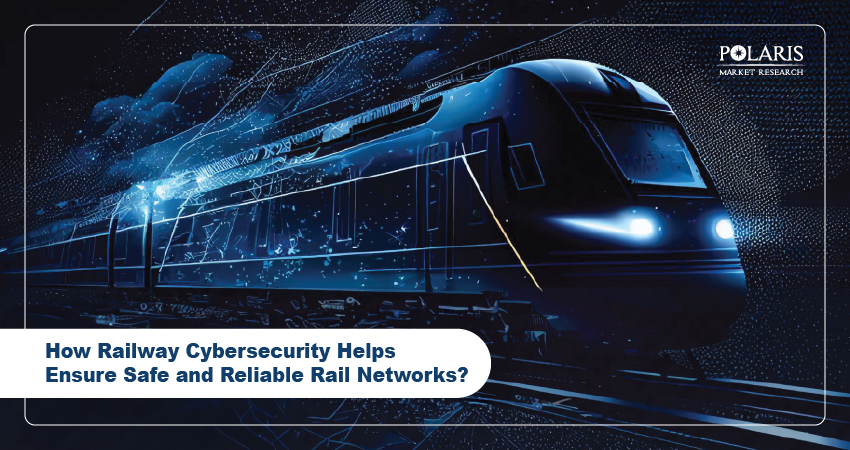How Railway Cybersecurity Helps Ensure Safe and Reliable Rail Networks?

Cyberattacks have become increasingly common in recent times. The threats of cyberattacks aren’t limited to IT environments across businesses and entities anymore. Public infrastructure, such as grids and railways, is also vulnerable to cyber threats. As such, the use of cybersecurity tools and techniques has increased to prevent and protect against these threats.
This blog post covers the importance of cybersecurity in the railway sector. It details the commonly used methods for railway security. The major stats for the railway cybersecurity market and the impact of artificial intelligence (AI) on the sector have also been detailed. Continue reading!
Railway Cybersecurity: Introduction
Railway systems have traditionally been considered safe. However, the introduction of digital commands has made them a viable target for cybercriminals. Railway systems now make use of open-platform equipment made using commercial off-the-shelf (COTS) components. The use of automated systems that can be remotely accessed using public or private networks has also increased.
Manipulating the digital commands and control networks can cause collisions between trains. Cybercriminals may attack ticketing machines. Passenger Wi-Fi systems and information displays are also vulnerable to cyberattacks.
Railway Cybersecurity Market Metrics
We’ve done a detailed analysis of the railway cybersecurity market. Our analysis reveals that the market for railway cybersecurity stood at USD 8.43 billion in 2024. The market is projected to grow at a CAGR of 9.9% during the projection period.
The rising number of cyberattacks has led to increased demand for railway cybersecurity solutions. Growing government initiatives for securing rail networks are also having a favorable impact on the railway cybersecurity market expansion.
Rising Digital Threats for Railways
There are several reasons why railway systems are targets for cyberattacks. Railways make use of a distributed architecture. The equipment lifecycle of these systems is considerably long. The supply chain and technology used in railways are diverse. Railway equipment is now increasingly connected with digital systems. The growing digitization of rail networks has made important signaling systems more vulnerable to cyber sabotage.
Growing digitalization has led to the adoption of modern signaling systems. Cloud analytics, positive train control systems, and rail train management systems are now a part of railway networks. Many rail networks also make use of predictive maintenance systems that are monitored by vendors. These modern systems have improved railway operations. However, they have also introduced threats to the safe and reliable functioning of trains.
IoT and Railway Cybersecurity
The growth of the IoT technology market has led to a number of connected devices being used on trains. For example, smart kettles are now present in buffet cars of various trains. These are affordable devices with little to no security. As such, they may provide an entry point for cybercriminals through the passenger network.
The concerning part is when the important control systems are connected to the same network used by passengers. In such instances, hackers may be able to get into the control systems without even being physically present on the train. Rail networks typically make use of wireless local area network (WLAN) technology for enabling train-to-ground communication. Vulnerabilities in key technologies can expose the WLAN to various risks. As such, appropriate security measures are essential for IoT systems in trains.
Solutions for Securing Railways
Cyberattacks are becoming increasingly sophisticated. As such, it’s important for railways to have proactive security measures instead of reactive practices. Below are the various ways in which rail networks can protect themselves against cyber threats:
Continuous Monitoring
An effective cybersecurity solution must be able to monitor the network continuously. It should also be able to provide alerts in real-time. That way, operators can have complete visibility into their network and address any potential threat quickly. Constant monitoring must be complemented by actionable insights so that operators can review alerts and take the next steps.
Proactive Measures
Proactive measures are needed across several aspects of the rail network. These include communication systems, power and traction control signaling, and business systems. Proactive measures help in identifying and limiting unauthorized transmissions. These measures also limit the transmission of data over lines other than the one on which the information is to be transmitted. Furthermore, proactive measures can provide information about abnormal performance or equipment failure.
Network Monitoring Solutions
Network monitoring solutions are capable of providing a detailed view of the entire network in real-time. The information provided by the solutions covers all levels of the network. This comprehensive visibility into the network helps in eliminating blind spots and also reveals the connections between assets. Network monitoring solutions are capable of analyzing passively captured data and determining the cybersecurity status of the network in real-time.
Hardwired Safety Systems
The use of hardwired safety systems in the system's architecture ensures that the reliance on software for safety features is eliminated. Many rail networks have this as a mandatory requirement when rolling stock emergency brake requests. Hardwired safety systems also ensure the physical and electronic separation of the on-train passenger network and networks used for controlling trains.
Impact of AI on Railway Cybersecurity
The AI in cybersecurity market is impacting railway cybersecurity in several positive ways. AI is capable of analyzing network patterns in real-time. This accelerates the pace at which potential cyberattacks are detected. AI-enabled automation protocols help improve response time, thereby reducing disruptions to operations. Regulatory requirements can also be met more effectively with the use of AI.
Final Words
Railway systems have become highly digitized. The use of advanced technologies in rail networks has enhanced passenger comfort and improved train operations. However, it has also made railways more vulnerable to cyberattacks. The railway cybersecurity market offers various solutions to ensure that rail networks remain safe and reliable.

